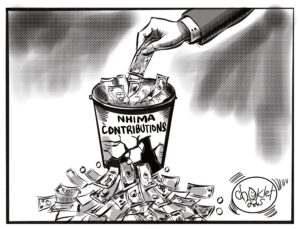The Zambian economy in 2024 underperformed relative to initial projections. Initially projected at 4.8 percent, the International Monetary Fund (IMF) revised the growth rate forecast downward twice to 2.3percent in June 2024 and 1.2percent towards end of year. In alignment with IMF forecasts, the Ministry of Finance and National Planning (MoFNP) reported consistent declines in quarterly gross domestic product (GDP), from 2.5 percent in the first quarter to 2.2 percent in the second quarter, and further to 1.7 percent in the third quarter. The poor economic performance was primarily driven by the prolonged droughts of 2024, which negatively impacted agricultural output and electricity supply, thereby reducing overall economic productivity.
The drought of 2024 had far-reaching consequences for Zambia’s agricultural sector, affecting over 9 million people across 84 districts. Reduced rainfall resulted in lower crop yields and exacerbated food insecurity in rural and peri-urban areas. The challenges extended beyond agriculture, with electricity shortages creating a significant strain on businesses. Small enterprises struggled to remain operational, while larger firms were forced to scale down production due to limited energy supply. These disruptions weakened employment prospects across key sectors, as electricity remains a vital input for most production processes. Unemployment remained high, with the Zambia Statistics Agency reporting levels at 12 percent.
Rising inflation compounded the sluggish growth experienced in 2024. According to the Zambia Statistics Agency, annual inflation averaged 15.7 percent in 2024 compared to 11.6 percent in 2023 and closed the year at 16.7 percent in December. Reduction in food production – which led to rising prices of key food commodities as demand outpaced supply, higher transportation and housing costs, and the depreciation of the Kwacha – produced a combined effect on rising inflation. This erosion of household purchasing power made basic goods less affordable, while businesses faced increased costs, especially for imported inputs.
On the revenue front, the Zambia Revenue Authority (ZRA) collected revenues in excess of 4 percent of the approved target of ZMK 125.3 billion, collecting a total of ZMK 130.9 billion. The revenues collected in 2024 represent a 30 percent increase compared to ZMK100.6 billion collected in 2023. Despite this growth, Zambia’s Tax-to-GDP ratio is about 20 percent, indicating that there is room for expanding the revenue base.
Debt remained a major concern throughout 2024. Zambia’s debt challenges date back to 2020, when the country defaulted on Eurobond repayments, becoming the first African country to do so during the COVID-19 pandemic. The lack of debt sustainability and ensuing debt distress prompted the government to continue seeking debt treatment under the G20 Common Framework in early 2021 to restructure the country’s unsustainable debt levels. In 2024, some progress was made, including reaching agreements with Eurobond holders and a bilateral agreement with France under the G20 Common Framework. However, the much-anticipated benefits of these efforts have yet to be felt by ordinary citizens as while there are signs of fiscal consolidation and restoration of some macroeconomic indicators the rising cost of living the reasons already highlighted continue to make life unbearable for ordinary citizens.
Across key sectors, MoFNP reported varied outcomes across the economy in 2024. In the mining sector, copper production in the first three quarters averaged 189,715 metric tonnes, an 8.5 percent increase compared to 174,805 metric tonnes in 2023. However, this progress falls short of the government’s incremental targets needed to achieve 3 million Metric Tonnes of copper production annually by 2031. With only six years remaining until 2031, the current production levels of copper if sustained, will not lead to the realization of the target.
The tourism sector, a priority under the 8th National Development Plan, faced operational challenges due to the energy crisis. Hotels and hospitality businesses turned to more expensive energy sources, while the Victoria Falls ran dry, reducing foreign tourist inflows. Meanwhile, the agricultural sector struggled under prolonged droughts, posing threats to national food security. Outdated farming practices remain a key obstacle, limiting productivity even in favorable rainfall years. Modernizing agricultural methods is essential to improve yields and enhance the sector’s ability to support livelihoods and food security.
Overall, the economic challenges of 2024 directly affected people’s livelihoods by eroding household incomes, disrupting small businesses, and reducing agricultural productivity, among other things. Policies for 2025 should focus on stabilizing the economy while addressing these impacts to improve living standards for citizens.
About the Author:
Elijah Mumba is a development economist and public finance expert. He currently serves as a Senior Researcher at the Centre for Trade Policy and Development and coordinates the Zambia Tax Platform and Civil Society Debt Alliance. He holds a master’s degree in development economics from the University of Cape Town, where he was a Mandela Rhodes Scholar.
























